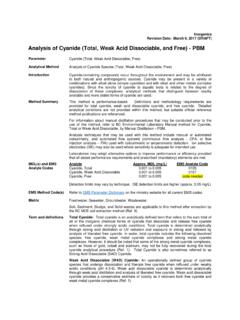Transcription of Electric Vehicle Ownership Costs - Consumer Reports
1 Electric Vehicle Ownership Costs : Today s Electric Vehicles Offer Big Savings for Consumers 2 Table of Contents Executive Summary 3 Key Terms 4 Chapter 1 Resale Value 5 Chapter 2 Maintenance 9 Chapter 3 Fuel Costs 12 Chapter 4 Current EV Ownership Costs 18 Chapter 5 Used EVs 26 Appendix A Fuel-Cost Sensitivities 29 Appendix B Fuel Costs by State 30 Appendix C Vehicle Characteristics 33 Appendix D Depreciation Curve 35 Appendix E Detailed Results of New-Car Ownership Cost Analysis 36 Appendix F Sensitivity Cases for New-Car Ownership Cost Analysis 38 Appendix G Detailed Results of Used-Car Ownership Cost Analysis 43 Electric Vehicle Ownership Costs : Today s Electric Vehicles Offer Big Savings for Consumers 3 Executive Summary Up-front purchase price is only part of the cost consumers pay to own their Vehicle . Over the lifetime of a conventional gas-powered Vehicle , fuel and maintenance Costs can add up to even more than the original purchase price.
2 While Electric vehicles (EVs) typically have higher up-front purchase prices, they can save consumers a lot on operating expenses. This study relies on new data on Electric Vehicle depreciation rates and maintenance and repair Costs , along with real world average Vehicle prices, to estimate how much today s most popular EVs can save consumers when compared with similar ICE vehicles. New data obtained by CR from ALG, a data and analytics subsidiary of automotive pricing and information website TrueCar, shows that when adjusted for federal purchase incentives, both battery Electric vehicles (BEVs) and plug-in hybrid Electric vehicles (PHEVs) are expected to depreciate at the same rate as ICE vehicles in the same class over the first five years of Ownership . In addition, new data extracted from recent Consumer Reports reliability surveys shows that both BEV and PHEV drivers are saving 50 percent on their repair and maintenance Costs , when averaged over a typical Vehicle lifetime.
3 Based on average driving habits, fuel Costs for BEVs were estimated assuming mostly home charging and an estimated six fast-charging sessions required per year for BEVs with a range of 250 miles. Overall, BEVs were estimated to save consumers about 60 percent on fuel Costs compared with the average Vehicle in their class. Fuel Costs were also analyzed by state, with the majority of states falling within 10 percent of the national average. The nine most popular EVs on the market under $50,000 were compared to (1) the best-selling, (2) the top-rated, and (3) the most efficient vehicles in their class. For six of the nine EVs analyzed, the first-owner Ownership Costs are estimated to be lower than those of all three comparable ICE vehicles in their class. For all nine EVs analyzed, the first-owner Ownership Costs are estimated to be lower for at least one of the three comparable ICE vehicles.
4 In many cases, the EVs matched or exceeded the performance of some of the top-performing ICE vehicles in their class. For all EVs analyzed, the lifetime Ownership Costs were many thousands of dollars lower than all comparable ICE vehicles Costs , with most EVs offering savings of between $6,000 and $10,000. While new EVs were found to offer significant cost savings over comparable ICE vehicles, the cost savings of 5- to 7-year-old used EVs was found to be two or three times larger on a percentage savings basis. Overall, these results show that the latest generation of mainstream EVs typically cost less to own than similar gas-powered vehicles, a new development in the automotive marketplace with serious potential Consumer benefits. Electric Vehicle Ownership Costs : Today s Electric Vehicles Offer Big Savings for Consumers 4 Key Terms Battery Electric Vehicle (BEV): A Vehicle that operates only on Electric power.
5 Depreciation: The portion of the initial value of an asset (such as a Vehicle ) that has been lost after a given amount of time. Depreciation is the inverse of the residual value. Discount rate: An interest rate used for discounting future income and expenditures relative to the present value. Electric Vehicle (EV): A Vehicle capable of operating on electricity only for an extended period of time. Includes battery Electric vehicles, plug-in hybrid Electric vehicles and fuel cell Electric vehicles1. Internal combustion engine Vehicle (ICE): A conventional Vehicle fueled only by gasoline. Plug-in hybrid Electric Vehicle (PHEV): A Vehicle that can operate on either electricity or gasoline. Present value (PV): A sum of future income and expenditures discounted to current year using a discount rate to take into account the fact that Costs and expenditures further into the future have a lower value in the present.
6 residual value: The portion of the original purchase price of a Vehicle remaining after a certain number of years. residual value is the inverse of depreciation. 1 There are currently no high-volume mainstream fuel cell Electric vehicles. Electric Vehicle Ownership Costs : Today s Electric Vehicles Offer Big Savings for Consumers 5 Chapter 1 Resale Value: Long-Range Electric Vehicles Expected to Hold Value As Well As Internal Combustion Engine Vehicles Introduction The Electric Vehicle market is rapidly changing, largely because the cost of batteries has decreased dramatically over the past One of the most significant changes is extended driving range. The 2011 Nissan Leaf, for example, had a single-charge range of only 73 miles, whereas the 2019 version had three times that range, at 226 miles. As of model year 2020, at least 11 Electric vehicles on the market have a range of 200 miles or more.
7 This sharp improvement in range delivers far more utility for many consumers. This increased utility is likely to be reflected in higher resale values for the current model year of the Leaf and other higher-range EV models. The purposes of this chapter are to test this hypothesis and estimate how the values of these Electric vehicles will hold up over time. The analysis relies on data from proprietary algorithms developed by ALG based on real-world Vehicle transaction prices adjusted by CR to account for government purchase incentives. Key Findings Current longer-range battery Electric vehicles (BEVs) are expected to maintain their value about as well as comparable internal combustion engine (ICE) vehicles, on average, over the next five years. Plug-in hybrid Electric vehicles (PHEVs) are expected to hold their value about as well as conventional hybrids of the same Vehicle class, on average, over the same period.
8 Approach ALG, a data and analytics subsidiary of automotive pricing and information website TrueCar provided CR with projected residual values of all model year 2019 vehicles after five years of Ownership as a percentage of the average original price for each model. These projections were made using proprietary algorithms and data from millions of real-world new and used Vehicle transactions. These residual value estimates were then adjusted to take into account the effect of purchase incentives available at the state and federal level on the original price of battery Electric and plug-in Electric vehicles. This was necessary because the net price after incentives represents 2 Electric Vehicle Ownership Costs : Today s Electric Vehicles Offer Big Savings for Consumers 6 the true price paid by consumers for these vehicles, and it is expected that both the new- and used-car markets will reflect the availability of these incentives.
9 ALG provided estimates of residual values based on the month of purchase, and the data were updated every two months throughout the year, resulting in six data points per year. Because incentives were phased out for some automakers General Motors and Tesla, for example at different points throughout the year, the incentives were applied only for the months in which they were offered, and the resulting residual values were averaged across the six data points for each Vehicle for the year. The value of the federal tax credit for each Vehicle model was taken from For state incentives, a weighted average incentive for all BEVs was derived by multiplying the percentage of EV sales in 2019 in a given state4 by the value of the state purchase incentive for Ten states provided purchase incentives for BEVs in 2019, and those states accounted for 65 percent of national EV sales. From this, it was calculated that, on average, BEV vehicles sold in 2019 each received $1,400 in state purchase incentives.
10 Because vehicles are often sold across state lines, we used this weighted average to approximate the effect of state incentives on the overall market. State tax credits were not calculated for PHEVs because of the complexity of how different state incentives apply to different specific PHEV models based on battery size. Detailed Results Electric vehicles were grouped into different segments, based on range and price, for analysis. Vehicles were segmented by whether they were classified as luxury or mainstream by TrueCar, and the mainstream EVs were divided by range: greater than 200 miles, between 100 and 200 miles, and under 100 miles. All luxury BEVs had a range of over 200 miles. Table shows a summary of the predicted five-year residual values for each category, with different levels of adjustment (adjusted for federal tax credit, and adjusted for both federal and state tax credits).








